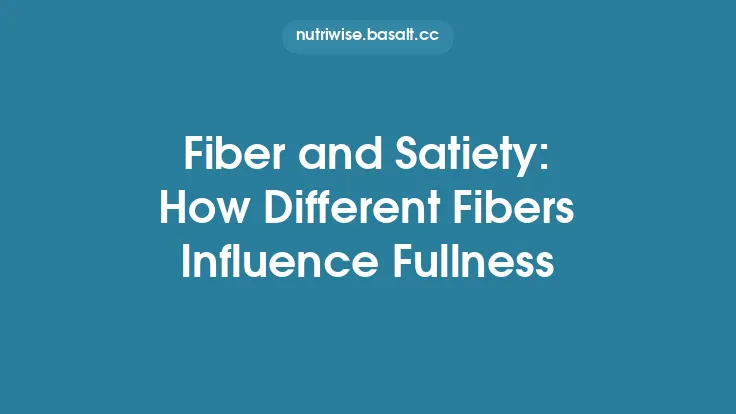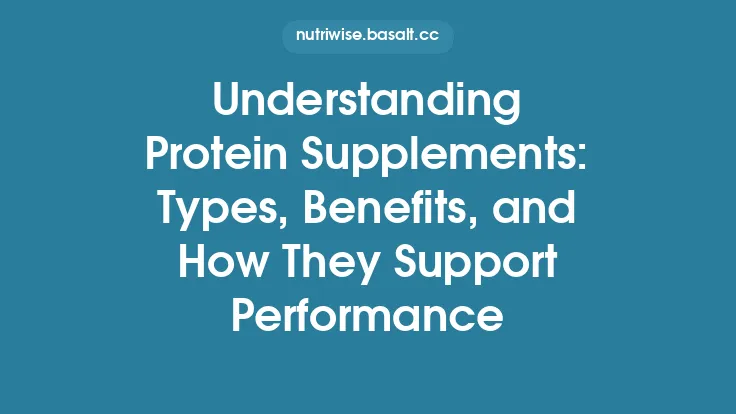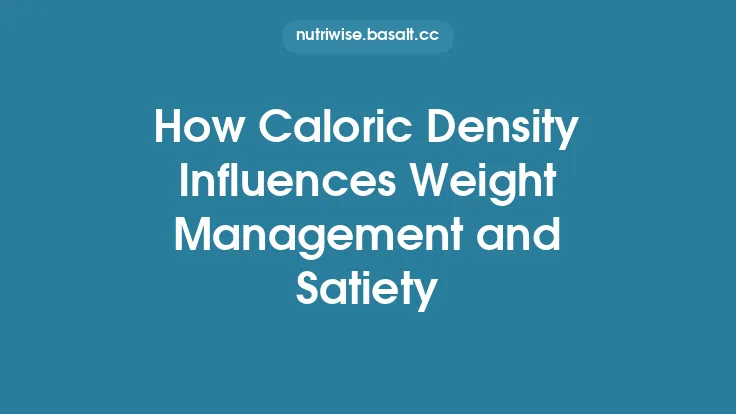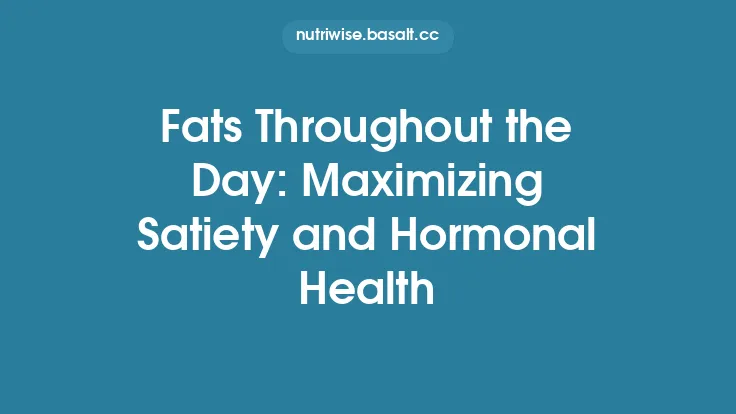Protein is widely recognized as the most satiating macronutrient, meaning it can help you feel fuller for longer and reduce overall calorie intake. This effect is not a simple by‑product of eating more food; rather, it stems from a combination of physiological, hormonal, and neural mechanisms that are activated when protein is consumed. Understanding how protein influences hunger can empower you to design meals and snacks that naturally curb cravings, support weight‑management goals, and promote steady energy levels throughout the day.
The Physiology of Satiety: Why Protein Stands Out
When you eat, several signals converge in the brain to tell you whether you are still hungry or comfortably full. Protein triggers three primary satiety pathways that are stronger or more prolonged than those activated by carbohydrates or fats:
- Hormonal Responses – Protein intake stimulates the release of appetite‑suppressing hormones such as peptide YY (PYY), glucagon‑like peptide‑1 (GLP‑1), and cholecystokinin (CCK). These hormones act on the hypothalamus and the vagus nerve to reduce the drive to eat. Studies consistently show that meals high in protein produce higher post‑prandial concentrations of PYY and GLP‑1 compared with iso‑caloric meals lower in protein.
- Gastric Emptying Rate – Protein slows the rate at which the stomach empties its contents into the small intestine. A slower gastric emptying curve prolongs the mechanical stretch of the stomach wall, a key signal for fullness. While fats also delay gastric emptying, protein does so without the same degree of caloric density, making it a more efficient satiety tool.
- Thermic Effect of Food (TEF) – Approximately 20‑30 % of the calories from protein are expended during digestion, absorption, and metabolic processing—a phenomenon known as the thermic effect. This elevated energy expenditure contributes to a modest increase in post‑prandial metabolic rate, which can indirectly reinforce the feeling of satiety by raising body temperature and activating sympathetic nervous system pathways linked to appetite control.
Key Hormones Modulated by Protein
| Hormone | Primary Action on Appetite | Protein‑Induced Change |
|---|---|---|
| Peptide YY (PYY) | Reduces hunger by acting on Y2 receptors in the arcuate nucleus | ↑ after high‑protein meals; peak at ~2 h |
| Glucagon‑like peptide‑1 (GLP‑1) | Slows gastric emptying, promotes insulin release, suppresses appetite | ↑ proportionally to protein dose |
| Cholecystokinin (CCK) | Stimulates pancreatic enzyme secretion, slows gastric emptying, signals satiety via vagal afferents | ↑ within 30 min of protein ingestion |
| Leptin (long‑term regulator) | Signals overall energy stores to the brain | Chronic high‑protein diets may improve leptin sensitivity, though acute meals have limited effect |
These hormonal shifts are not isolated; they interact synergistically. For example, CCK‑mediated slowing of gastric emptying enhances the release of PYY and GLP‑1, creating a feedback loop that sustains fullness.
Protein’s Impact on Hunger‑Related Brain Regions
Functional MRI studies have identified reduced activation in the insula and orbitofrontal cortex—areas associated with the reward value of food—after participants consume protein‑rich meals. Simultaneously, there is increased activity in the ventromedial hypothalamus, a region that signals satiety. This neural pattern explains why protein can diminish cravings for highly palatable, energy‑dense foods such as sweets and fried snacks.
Practical Applications: Designing Satiety‑Optimized Meals
1. Prioritize Protein at the Start of a Meal
Consuming 20‑30 g of protein within the first 10–15 minutes of a meal (e.g., a Greek‑yogurt parfait, a boiled‑egg, or a protein shake) can jump‑start the hormonal cascade that curtails subsequent intake. This “protein front‑loading” strategy is especially useful for individuals who tend to overeat during lunch or dinner.
2. Distribute Protein Evenly Across the Day
Research indicates that spreading protein intake across 3–5 meals yields more consistent satiety signals than loading most protein into a single meal. Aim for 0.3–0.4 g of protein per kilogram of body weight per eating occasion. For a 70 kg adult, that translates to roughly 21–28 g of protein per meal.
3. Combine Protein with Fiber‑Rich Carbohydrates
Fiber adds bulk and further slows gastric emptying, while also promoting the production of short‑chain fatty acids that have independent appetite‑suppressing effects. Pairing protein with high‑fiber foods (e.g., legumes, whole grains, vegetables) creates a “double‑hit” satiety effect.
4. Choose Protein Sources with High Satiety Index Scores
Not all proteins are created equal in terms of satiety. Empirical satiety index rankings place whey, casein, egg, and lean meat among the top performers, while plant proteins such as soy and pea score slightly lower—largely due to differences in digestion speed and amino acid composition. However, when combined with fiber or fat, plant proteins can achieve comparable satiety outcomes.
5. Mind the Cooking Method
Processing that denatures protein (e.g., excessive heat, extensive grinding) can alter its digestion kinetics. For satiety purposes, minimally processed forms—such as whole eggs, grilled chicken breast, or intact tofu—preserve the protein’s structural integrity, leading to a more gradual release of amino acids and a prolonged fullness signal.
Evidence from Controlled Feeding Trials
- Acute Meal Studies: In a crossover trial where participants consumed iso‑caloric meals containing 10 % vs. 30 % of calories from protein, the high‑protein condition reduced subsequent energy intake by an average of 350 kcal over the next 24 hours.
- Long‑Term Weight‑Loss Interventions: Meta‑analyses of randomized controlled trials show that diets with ≥25 % of total energy from protein result in 0.5–1.0 kg greater weight loss over 12 months compared with lower‑protein diets, largely attributed to reduced spontaneous energy intake.
- Appetite‑Rating Scales: Visual analogue scales (VAS) consistently record lower hunger scores and higher fullness scores after high‑protein breakfasts, with effects persisting for up to 5 hours post‑meal.
Special Populations and Satiety
| Population | Considerations | Practical Tips |
|---|---|---|
| Older Adults | Age‑related blunted hormonal responses; risk of sarcopenia | Emphasize high‑quality protein (e.g., whey, dairy) and ensure ≥1.2 g kg⁻¹ day⁻¹ to support both muscle health and satiety |
| Athletes | Higher total protein needs; frequent meals | Use protein‑rich recovery snacks (e.g., chocolate milk, protein bars) to sustain satiety between training sessions |
| Individuals with Diabetes | Post‑prandial glucose spikes can affect hunger | Pair protein with low‑glycemic carbs to blunt glucose excursions and maintain steady satiety |
| Vegetarians/Vegans | May rely on plant proteins with lower satiety indices | Combine multiple plant sources (e.g., lentils + quinoa) and add fiber‑rich vegetables to boost fullness |
Potential Pitfalls and Misconceptions
- “More protein always means more satiety.” While protein is potent, excessive intake (>2 g kg⁻¹ day⁻¹ for most adults) does not further enhance satiety and may displace other essential nutrients.
- “Protein alone can replace all other macronutrients.” Balanced meals that include healthy fats and complex carbohydrates are necessary for optimal nutrient absorption, energy balance, and long‑term adherence.
- “All whey protein powders are equally satiating.” The satiety effect varies with formulation; isolates (high protein, low lactose) tend to be more rapidly digested and may produce a shorter satiety window than concentrates or hydrolysates that retain some slower‑digesting components.
Designing a Satiety‑Focused Meal Plan (Sample)
| Time | Meal | Protein (g) | Key Satiety‑Boosting Components |
|---|---|---|---|
| 07:30 | Greek yogurt (200 g) + mixed berries + 1 tbsp chia seeds | 20 | Dairy protein, fiber, omega‑3 |
| 10:00 | Hard‑boiled egg + whole‑grain toast | 12 | Egg protein, complex carbs |
| 13:00 | Grilled salmon (120 g) + quinoa (½ cup) + roasted broccoli | 30 | Fish protein, whole grain, fiber |
| 16:00 | Cottage cheese (150 g) + sliced cucumber | 18 | Casein protein, low‑calorie veg |
| 19:30 | Stir‑fried tofu (150 g) + mixed vegetables + brown rice (½ cup) | 25 | Plant protein, fiber, low‑GI carbs |
| 21:30 | Protein shake (whey isolate, 25 g) + almond milk | 25 | Fast‑acting protein for overnight satiety |
Total daily protein ≈ 130 g, distributed roughly evenly, each meal paired with fiber‑rich foods to maximize satiety.
Summary
Protein’s unique ability to curb hunger stems from a coordinated set of hormonal releases, slowed gastric emptying, and a higher thermic effect, all of which converge on brain regions that regulate appetite and reward. By strategically incorporating 20‑30 g of high‑quality protein into each eating occasion, pairing it with fiber‑dense carbohydrates, and selecting minimally processed sources, you can harness these mechanisms to achieve sustained fullness, lower overall calorie intake, and support long‑term health goals. Whether you are managing weight, optimizing performance, or simply seeking steadier energy throughout the day, understanding and applying the satiety properties of protein offers a practical, evidence‑based tool for better dietary control.




